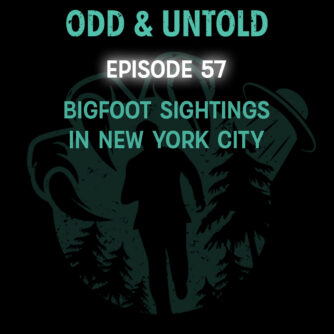In honor of Saint Patrick’s Day, let’s travel to Ireland for what some call blarney and others say is the coolest dog-otter around: the Dobhar Chu.
The Dobhar Chu (or Dobhar-chú) lives in whatever body of water is convenient—lakes, seas, oceans, possibly a city pool if well-located. With its glossy, dark fur, the creature is described as looking like an otter but with some resemblance to a canine. In terms of size, everyone likes to compare the Dobhar Chu to a crocodile. Not the size of the similarly proportioned anteater, but equivalent dimensions to a crocodile. That’s probably because even as shoes, crocs are scary.
A commonly cited Dobhar-chú habit is a whistling sound, most often released when the poor creature is dying or otherwise perturbed. Some assert the whistle is high-pitched and super creepy, but witnesses might be inclined to say that because they just saw a giant otter with razor-sharp fangs. Even if the beast tried to curtsy, the polite gesture would still seem sinister.

Dobhar Chus are renowned romantics. Because most reports describe them as always being in pairs, the creatures might mate for life. A Dobhar Chu couple basically hunts like Michael Crichton velociraptors: one makes its appearance and the other surreptitiously lies in wait. If the visible Dobhar Chu needs help, the concealed one pops out and gnashes some flesh. And if you’re going to kill a Dobhar Chu, be prepared to take them both down. Men who claim to have assailed one creature allege that the second became wilder and more ferocious after seeing its mate’s demise. Like I said, the beasts are devoted sweethearts. And really, don’t we all want to find a partner who will fearlessly avenge our death? Hollywood should make a sweeping romantic epic about this cryptid. Or a rom com.
One infamous account of the Dobhar Chu occurred in 1722 at Glenade Lake. The story goes that Grace Connolly was alone in the water, either bathing or laundering clothes. Though no one witnessed the attack, a Dobhar Chu is said to have risen from the lake and savagely ripped open her chest. Eventually, when his wife didn’t come home to cook him dinner, Grace’s husband Terence came looking for her. He maintained that the Dobhar Chu was still chilling next to his wife’s dead body. This is rather circumstantial evidence at best. Perhaps the Dobhar was trying to revive his wife by performing some nautical form of CPR.
Not in the mood for a lengthy trial, Terence proceeded to kill the creature, but it released its death rattle whistle and the mate appeared, prepared to take revenge. Terence galloped off on his horse and eventually confronted the Dobhar spouse elsewhere on land, killing it as well. While there’s a twelve stanza ballad about the event, no living witness except Terence (and in some accounts, his brother) ever saw the creature. Something makes me wonder if old Terence just wanted to get rid of Grace and thought that using a terrifying legend as a cover-up would dispel suspicion. Either way, people say you can visit Grace’s grave today, which features an engraving of a Dobhar Chu.

Because the instrument of your demise should always be celebrated on your tomb
For a quick side note, the men who come up against these creatures always live to tell the bloody tale of how they slew the Dobhar Chu and its mate, but a single woman who faced one is mauled and killed. I smell a didactic, ‘keep your wives and daughters at home’ fable. The Dobhar Chu calls blarney.
As a result of these stories, people like to throw around the words ‘gruesome’ or ‘bloodthirsty’ in reference to the Dobhar Chu. Quite frankly, the whole thing’s probably a huge misunderstanding. If this creature is indeed real and unabashedly fierce, then countrymen and women would have been ripped apart at least once or twice annually over the years. One alleged death and a few scattered assaults in the past three centuries fail to meet the threshold to declare it a murderous species. Many animals are territorial, and hapless humans who encroach on its land might fall victim to its protective actions. Now this is not to let the Dobhar off scot-free. It’s completely uncool to attack people for any reason, and if it rips them to bits just for fun (or for food), then that’s pretty low. But the Dobhar Chu is unlikely to be as homicidal as some accounts claim.

Perhaps most interestingly, many think the Dobhar-chú is simply Ireland’s name for what Scotland dubs the Loch Ness Monster. At seven feet long, that could easily be a Nessie. Yes, people who report sightings at Loch Ness usually recall the beast spanning a mile. But if you spot what you assume to be a sea serpent, is seven feet really that different from twenty? And how exactly do people judge length anyhow? Do you have a penny nearby for scale? Consequently, a giant black otter could provide an explanation, though I still favor the plesiosaur theory. In any event, there might well be an uncategorized species out there in the waters of Ireland, in the form of a rare otter.
So if you ever meet a pair of Dobhar Chus, be careful not to pass judgment based on the myths. The Mister and Missus are probably on vacation for the season. That being said, don’t try to pet them or anything. The creatures do sound temperamental. And don’t be foolish enough to harm their mate. Nothing’s stronger than true Dobhar Chu love.




[…] as I’ve lamented before with the Dobhar Chu, many of these tales stink of didactics. In Victorian times, women were viewed as being more […]
[…] than make some kind of deathbed confession or tell his family that he loved them. Much like the Dobhar Chu, a family member of Hans Fuchs memorialized the Tatzelwurm by painting the creature Fuchs […]